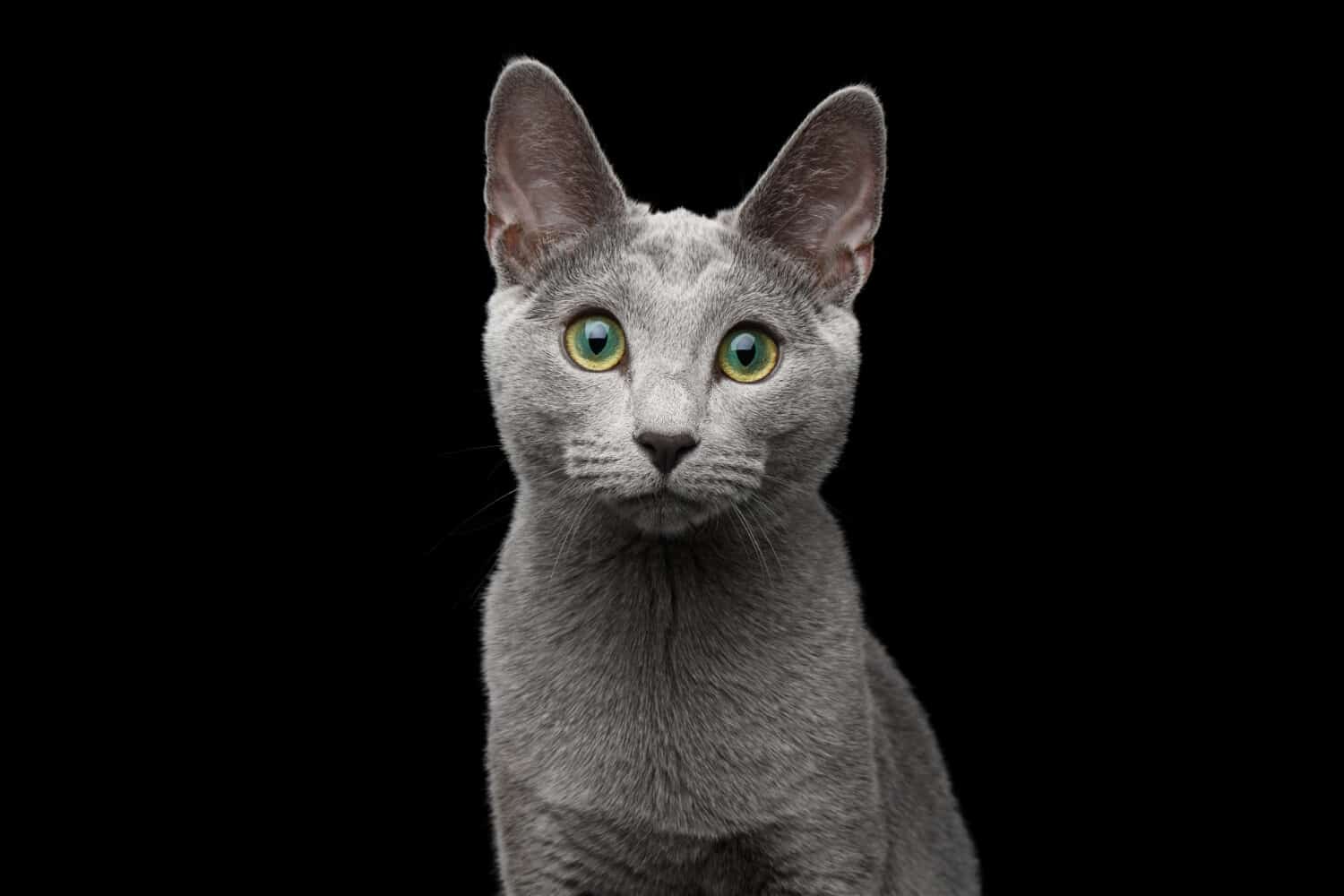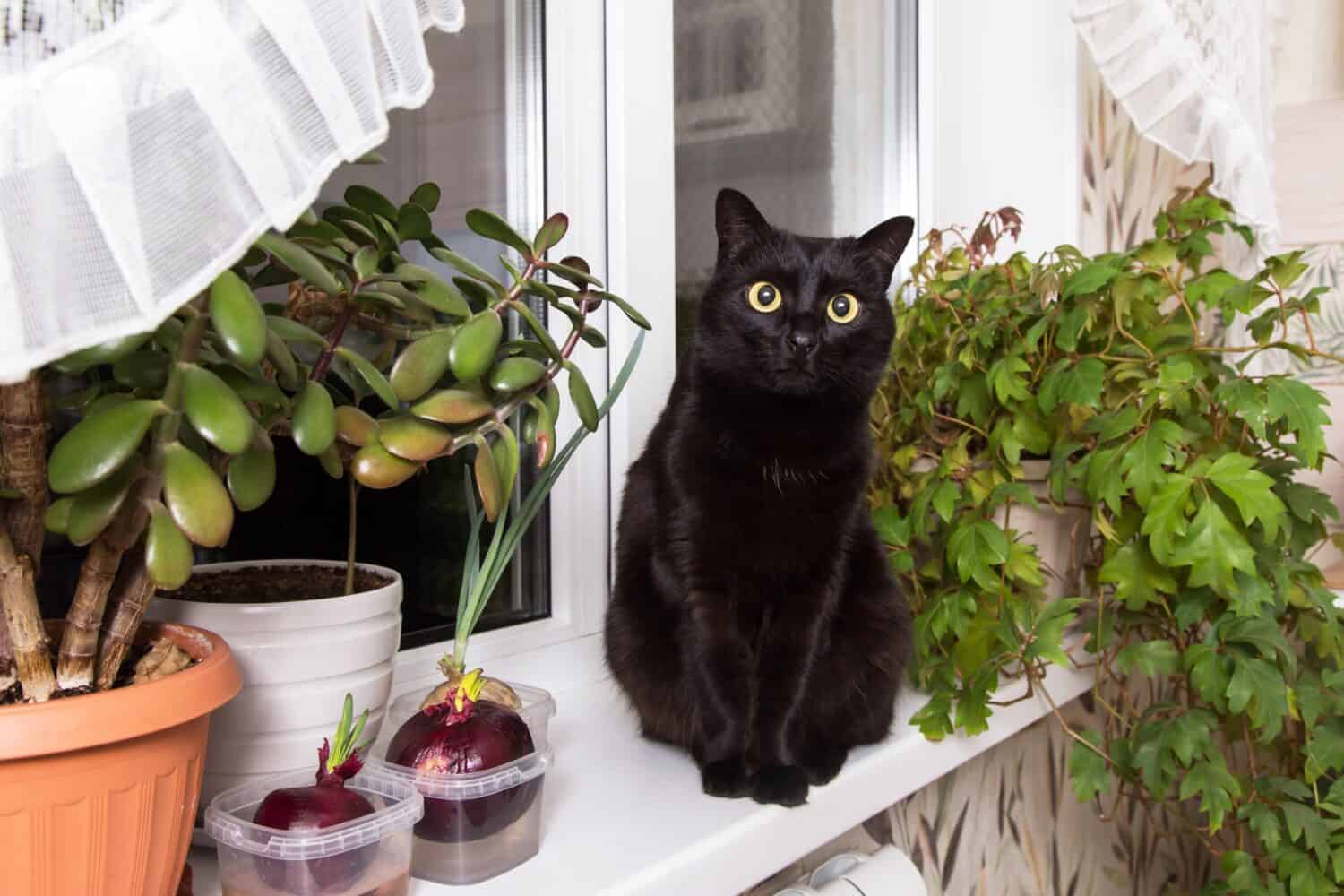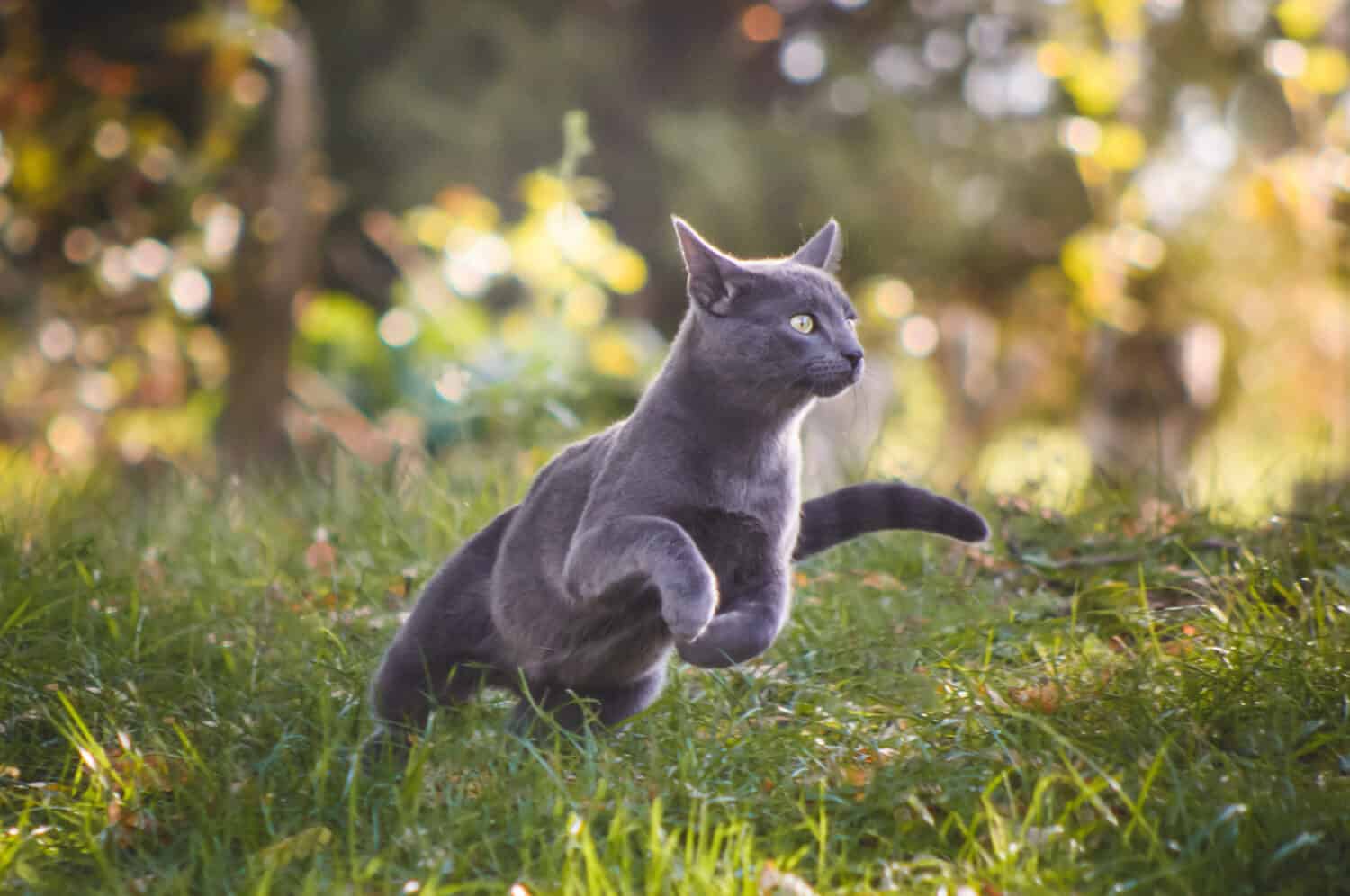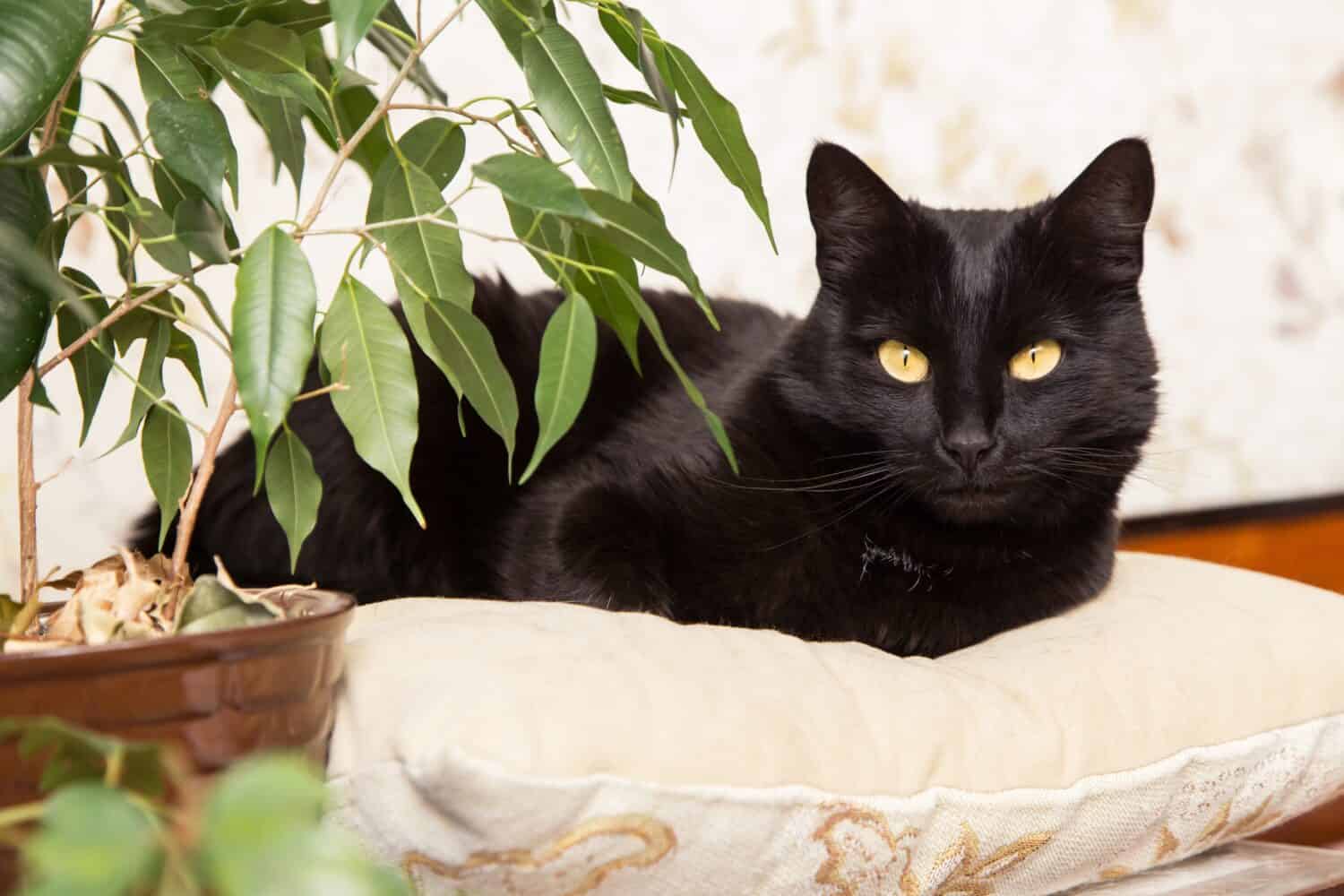Within the diverse world of domestic cats, two distinct breeds stand out for their unique characteristics and captivating personalities: the Russian Blue and the Bombay. These feline companions may share certain physical similarities, such as their sleek coats and expressive eyes. However, they have notable differences in appearance, temperament, and other aspects. In this article, we will explore the key contrasts between the Russian Blue vs Bombay cat, shedding light on their distinguishing features.

Russian Blue cats are an elegant and sophisticated breed by appearance.
©Seregraff/Shutterstock.com
What Are the Key Differences Between the Russian Blue vs Bombay Cat?
| Russian Blue | Bombay |
|---|---|
| They are a naturally occurring breed from Russia in the 1800s. | They were established in the 1960s by breeder Nikki Horner in the US, developed from sable Burmese and black American Shorthair cats. |
| This breed has a short, dense coat of silver-blue to slate gray-blue colors. Their paw pads can be pinkish lavender or mauve. | This breed has short, sleek black coats with black paw pads, noses, and mouths. |
| Russian Blues have bright eyes in shades of green. | Bombay cats’ eyes come in copper, amber, or gold shades. |
| They are small to medium-sized with an average weight of 8 to 15 lb. | They are medium-sized with a muscular build, weighing 8 to 15 pounds. |
| This breed has long and slender bodies with a lustrous appearance. | This breed has graceful and elongated bodies, with rounded heads and straight, rounded-tipped ears. |
| Russian Blues have a reserved and loving temperament, preferring routine schedules. They are intelligent with an excellent memory. | Bombays are a highly sociable, vocal, and energetic breed. They are intelligent, curious, and demanding of attention. |
| This breed is not prone to common health or genetic issues. | This breed can have a few common health issues, including hypertrophic cardiomyopathy, excessive tearing of the eyes, and sinus problems. |
| Russian Blues have the potential to be better tolerated by individuals with allergies due to less production of glycoprotein Fel d 1. | Bombays produce the average amount of glycoprotein Fel d 1 expected in a cat. |

Bombay cats are long and slender with jet-black coast and golden eyes.
©dien/Shutterstock.com
Appearance
The Russian Blue cat is elegant and has a refined appearance. Its medium-sized body with a muscular yet slender build gives it a graceful posture. Its striking feature is its dense, short double coat, which boasts a bluish-gray hue, often described as “blue.” The fur’s silver-tipped hairs create a shimmering effect, adding to the breed’s allure. The Russian Blue’s eyes are large, round, and vivid green, further enhancing its captivating gaze.
In contrast, the Bombay cat is the epitome of elegance and sophistication. It showcases a compact and muscular yet slender body, reflecting its inherent agility and strength. The Bombay’s most distinguishing trait is its sleek, short black coat, often compared to a panther’s. Its velvety fur shines brilliantly, exuding a glossy finish that enhances its regal appearance. Complementing its luxurious coat, the Bombay cat possesses large, expressive copper or gold eyes, providing a stunning contrast against the dark backdrop.
Temperament
When it comes to temperament, the Russian Blue vs Bombay cat has distinct differences.
Russian Blues are reserved and have a gentle nature. While they may be initially cautious around strangers, they tend to develop strong bonds with their family members. These cats are generally quiet and dignified, preferring a serene and harmonious environment. Russian Blues thrive on routine and stability, and sudden changes in their environment may cause them stress. Despite their reserved nature, they are affectionate companions, often forming a deep connection with their owners. They enjoy peaceful laps and are content observers of their surroundings.
On the other hand, the Bombay cat boasts a lively and extroverted temperament. This breed is playful and has a mischievous nature, often entertaining its owners with its acrobatic skills and playful antics. Bombays are highly sociable and thrive on interaction. They eagerly seek attention and affection, making them excellent companions for households with children or other pets. This breed possesses a curious and adventurous spirit, always ready to explore its surroundings and engage in interactive play.
Cost
When considering the acquisition of a Russian Blue or Bombay kitten, it is essential to consider the associated costs. The average cost of a Russian Blue kitten from a reputable breeder ranges from $500 to $1,200. This price can vary depending on factors such as the breeder’s reputation, the kitten’s pedigree, and the region where the breeder operates. Additionally, show-quality Russian Blue kittens with exceptional lineage may command prices well above $2,000.
In comparison, true Bombay kittens are slightly rarer when compared to Russian Blue kittens. The average price for a true Bombay kitten from a reputable breeder ranges from $500 to $2,000. This higher cost reflects the breed’s exclusivity and unique characteristics. As with Russian Blues, factors such as the kitten’s pedigree, breeder reputation, and geographical location can influence the overall price.
It’s worth noting that adopting a cat from a rescue organization or shelter can be a more cost-effective option. These organizations often have cats of various breeds, including Russian Blues and Bombays, available for adoption at lower prices, closer to the $150 to $300 range. Additionally, adopting from a shelter provides a loving home for a cat in need.
Other Differences
Beyond their appearance and temperament, the Russian Blue vs Bombay cat compare in several other aspects. Here are some additional comparisons.
Vocalization
Russian Blues are generally quiet cats, expressing themselves through subtle gestures and body language. They are not prone to excessive vocalization. In contrast, Bombays are more vocal. They may communicate through soft trills and chirps, engaging in conversations with their owners.
Grooming Needs
Both breeds have low grooming requirements, thanks to their short coats. The Russian Blue’s double coat is dense and requires minimal attention, with occasional brushing to remove loose hairs. Similarly, the Bombays’ sleek coat is relatively low-maintenance, only requiring regular brushing to maintain its glossy appearance.
Intelligence
Russian Blues are highly intelligent. They are quick learners and enjoy engaging in puzzle toys and interactive games that stimulate their minds. Bombays also exhibit intelligence and thrive on mental stimulation. They are highly trainable and can learn tricks and commands with dedication and positive reinforcement.
While the Russian Blue and Bombay cats may share some physical resemblances, their differences in characteristics and temperament set them apart. The Russian Blue captivates with its refined elegance, reserved nature, and deep bond with its family members. In contrast, the Bombay emanates an air of sophistication, boasting a playful and sociable personality that thrives on interaction. Understanding these divergent traits can help potential owners determine which breed aligns best with their preferences and lifestyle.
Now that we’ve compared the Russian Blue vs Bombay cat let’s explore the individual breeds.

Bombay cats have various round features and are incredibly mischievous.
©Viktor Sergeevich/Shutterstock.com
Russian Blue Overview
The Russian Blue cat is a captivating breed with a rich history and unique characteristics. Originating from Russia in the 19th century, this naturally occurring breed has garnered recognition and admiration for its striking appearance and gentle temperament.
Origin
The Russian Blue likely originated in Russia during the 1800s. While the exact origins remain unclear, this breed’s natural occurrence caught the attention of cat enthusiasts. The Cat Fanciers Association recognized the Russian Blue for registration in 1949, solidifying its place among distinguished cat breeds.
Characteristics
The Russian Blue showcases a stunning array of physical features that contribute to its allure. Its most notable characteristic is its short, dense coat, which ranges in color from light silver-blue to slate gray-blue. This beautiful coat is complemented by bright, almond-shaped eyes in shades of green, imparting a captivating gaze. Additionally, Russian Blues possess pinkish lavender or mauve paw pads and a distinctive double coat, providing them with insulation and a velvety texture.
This breed exhibits a small to moderate size, with adult cats typically weighing between 8 to 15 pounds. Males generally tend to be larger than females. The Russian Blue’s body is long and slender, giving it an elegant appearance. Its coat carries a sheen or lustrous quality, which is incredibly soft to the touch. The breed features a triangular-shaped head with a broad forehead, large ears, and a straight nose, contributing to its refined and graceful look.
Temperament
The Russian Blue is gentle and has a composed temperament. This breed tends to be a quiet companion, preferring serene surroundings. When around strangers for the first time, Russian Blues are reserved at first but gradually open up. They form strong bonds with their family members. They are loving and easy-going, often seeking moments of quiet affection and companionship with their human counterparts.
Russian Blues thrive on predictability and routine, preferring stable environments. They are not fond of sudden changes and find comfort in regular schedules. This breed’s intelligence shines through as they display excellent memory and problem-solving abilities. Their inquisitive nature and alertness contribute to their ability to adapt to their surroundings while maintaining a sense of calm.
Allergen Perks
Interestingly, individuals with mild to moderate allergies may tolerate the Russian Blue better. There is speculation that this breed produces less glycoprotein Fel d 1, one of the primary allergens associated with cat allergies. While individual reactions may vary, those with mild to moderate cat sensitivities may find the Russian Blue more compatible.
Health and Genetics
The Russian Blue isn’t prone to common health issues or genetic disorders. This breed generally enjoys robust health, although regular veterinary care and a balanced diet are essential for overall well-being. As with any cat, proper nutrition, regular exercise, and routine health check-ups are crucial to ensure their long-term health and happiness.

Russian Blue cats are highly intelligent and form strong bonds with their owners.
©ddisq/Shutterstock.com
Bombay Overview
The Bombay cat is an intriguing breed known for its sleek black coat, captivating eyes, and sociable nature. Originating in the United States in the 1960s, this breed has gained popularity for its panther-like appearance and charismatic personality.
Origin
Breeder Nikki Horner established the Bombay breed in the 1960s in Louisville, KY. Horner aimed to create a feline companion resembling a panther’s elegance and mystique. The breed’s development involved crossing sable Burmese cats with black American Shorthair cats. Through selective breeding, the Bombays’ distinctive traits were refined and consolidated.
Characteristics
The Bombay cat boasts a stunning and unique set of characteristics contributing to its allure. Its most striking feature is its short, sleek coat, resembling that of a panther. The coat is entirely black, from the tips of its fur to its paw pads, nose, and mouth. Their eyes enhance this monochromatic beauty in shades of copper, amber, or gold, which provide a captivating contrast against the dark backdrop.
Moreover, in terms of physical attributes, the Bombay cat has a medium-sized body with a muscular build. Adult Bombay cats typically weigh between 8 and 15 pounds, with males being slightly heavier than females. Their bodies are gracefully elongated, accompanied by a long, elegant tail that accentuates their overall poise. The breed exhibits a rounded and short head adorned with straight ears that are rounded at the tips, further enhancing their adorable and distinctive appearance.
Temperament
The Bombay cat is sociable and has an extroverted nature. This breed thrives on human companionship and seeks frequent interaction and attention. Highly vocal and expressive, Bombays use their voices to communicate with their owners and engage in lively conversations. Their intelligent nature allows them to quickly learn and understand their human counterparts, making them a delight to interact with.
Furthermore, Bombay cats have high energy levels and a playful disposition, similar to monkeys. They enjoy interactive games, toys, and activities that stimulate them mentally and physically. This breed’s curious nature drives them to explore their surroundings and actively participate in household activities. Their sociable temperament makes them excellent family companions, including children and other pets.
Health and Genetic Considerations
While the Bombay cat is generally a healthy breed, there are some common health issues to be aware of. One notable condition is hypertrophic cardiomyopathy, a heart disease that can affect cats. Regular veterinary check-ups are essential to monitor and maintain their overall cardiac health. Additionally, Bombays may experience excessive tearing of the eyes and sinus problems due to their unique head shape and short muzzle.

The Bombay is an extroverted breed of cat.
©Viktor Sergeevich/Shutterstock.com
Conclusion
The Russian Blue vs Bombay cat stands out as a unique and captivating breed. While they share some similarities in terms of their sleek coats and striking appearance, they possess distinctive characteristics that set them apart.
The Russian Blue, originating from Russia in the 19th century, exudes an air of refinement and elegance. Its short, dense coat, ranging from silver-blue to slate gray-blue, and its vivid green eyes create an enchanting combination. With their reserved and gentle nature, Russian Blues form strong bonds with their families while preferring a calm and predictable environment. These intelligent cats thrive on routine and have excellent memory, making them observant and adaptable companions.
On the other hand, the Bombay cat, established in the United States in the 1960s, captivates with its panther-like appearance. Its sleek black coat, paired with eyes in copper, amber, or gold shades, creates a striking and alluring look. Bombays are highly sociable, energetic, and vocal, demanding attention and interaction. With their intelligence and curiosity, they engage in playful antics and make affectionate companions.
Both Breeds Are Unique
While both breeds have a unique charm, it’s important to consider individual preferences and lifestyles when choosing a feline companion. Russian Blues offer a serene and loving presence, ideal for those seeking a quiet and calm cat. Their hypoallergenic qualities may also benefit individuals with mild to moderate allergies. On the other hand, the Bombay cat’s sociable and lively nature brings energy and liveliness to households, making them great companions for families and active individuals. A resource when searching for reputable breeders would be the Fanciers Breeder Referal List.
In summary, the Russian Blue and Bombay cats each possess their own set of characteristics and temperaments that make them special. Whether the elegance of the Russian Blue or the panther-like allure of the Bombay captivates you, both breeds bring joy, companionship, and unique experiences to the lives of their owners.
The photo featured at the top of this post is © dien/Shutterstock.com
Thank you for reading! Have some feedback for us? Contact the AZ Animals editorial team.







